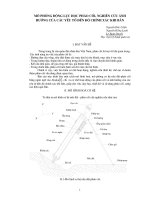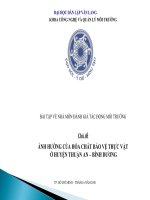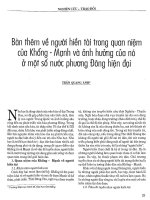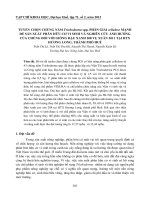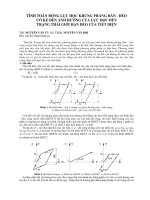bản chất về cáp dự ứng lực ví dự thiết kế cáp ảnh hưởng của cáp dự ứng lực
Bạn đang xem bản rút gọn của tài liệu. Xem và tải ngay bản đầy đủ của tài liệu tại đây (19.09 MB, 201 trang )
CIVL 3121
Influence Lines - Part 3
1/5
Live Loads for Bridges
Live Loads for Bridges
In our previous discussions we mentioned that the
primary live loads on bridge spans are due to
traffic.
The heaviest loads are those produced by large
transport trucks.
The American Association of State and Highway
Transportation Officials (AASHTO) has a series of
specifications for truck loadings.
For two-axial trucks AASHTO designates these
vehicles as H series trucks.
For example, a H15-44 is a 15-ton truck as
reported in the 1944 specifications.
Trucks that pull trailers are designated as HS, for
example HS 20-44 (a 20-ton semi-trailer truck).
In general, a truck loading depends on the type of
bridge, its location, and the type of traffic
anticipated.
Live Loads for Bridges
Live Loads for Bridges
The size of the “standard truck” and the distribution of its
weight is reported in the AASHTO code.
The “H” loading consists of two-axial truck
The number following the H designation is the gross weight
in tons of the standard truck
The “HS” loading consists of tractor truck with semi-trailer
The number following the HS designation is the gross
weight in tons of the standard truck
14 feet
H 20-44 8 kips
H 15-44 6 kips
32 kips
24 kips
0.1 W
0.4 W
0.1 W
0.4 W
HS20-44 8 kips
HS15-44 6 kips
32 kips
24 kips
32 kips
32 kips
W = Total weight of truck and load
Live Loads for Bridges
The AASHTO standard H20 and HS20 trucks
Live Loads for Bridges
The AASHTO specifications also allow you to
represent the truck as a single concentrated load
and an uniform load.
For H20-44 and HS20-44:
Concentrated load
18 kips for moment
26 kips for shear
Uniform loading
640 lb/ft of load lane
CIVL 3121
Influence Lines - Part 3
Live Loads for Bridges
2/5
Live Loads for Bridges
The AASHTO specifications also allow you to
represent the truck as a single concentrated load
and an uniform load.
You can probably see that once the loading has
been selected, you have to determine the critical
position of the truck on the structure (bridge).
For H15-44 and HS15-44:
This is an excellent application for influence
lines.
Concentrated load
13.5 kips for moment
19.5 kips for shear
Uniform loading
480 lb/ft of load lane
Live Loads for Bridges
In many cases, vehicles may bounce or sway as
they move over a bridge.
This motion produces an impact load on the
bridge.
AASHTO has develop an impact factor to
increase the live load to account for the bounce
and sway of vehicles.
I
Live Loads for Bridges
Impact loading is intended to transfer loads from the
superstructure to the substructure
Superstructures including legs of rigid frames
Piers excluding footings and those portions below
ground line
Portions above ground line of concrete and steel piles
that support the super structure
50
0.3
L 125
where L is the length of the span in feet
Live Loads for Bridges
Impact shall not be included in loads transferred to
footings or to those parts of piles or columns that
are below ground
Live Loads for Bridges
Example: Consider our standard AASHTO HS20-44 truck
traveling over the span of some structure.
8k
Abutments, retaining walls, piles excepts as specified
before
Foundation pressures and footings
Timber structures
Sidewalk loads
Culverts and structures having 3 feet or more of cover
A
x
32 k
14 ft.
32 k
30 ft.
B
CIVL 3121
Influence Lines - Part 3
Live Loads for Bridges
3/5
Live Loads for Bridges
Shear - To examine how a series of concentrated
loads effect the shear lets consider our “standard
truck” and its effect on the shear at point C on the
beam shown above.
First we need the influence line for the shear at
point C.
Using the Muller-Breslau principle construct the
influence line for the shear at point C
V
50 ft.
50 ft.
A
V
B
VC
50 ft.
A
50 ft.
C
The change in
shear is equal to 1
B
0.5
x
-0.5
Live Loads for Bridges
Live Loads for Bridges
Let’s try to find the maximum positive shear at point C.
There are three cases to examine, one for each of the
three wheel forces as they pass over the point C .
8k
Case #1
32 k
14 ft.
A
VC
32 k
B
0.36
x
VC
32 k
30 ft.
B
0.5
50 ft.
-0.06
-0.2
50 ft.
-0.5
VC Case 3 8k ( 0.06) 32k ( 0.2) 32k (0.5)
50 ft.
-0.36
x
-0.5
19.52k
Live Loads for Bridges
Let’s try to find the maximum positive shear at point C.
There are three cases to examine, one for each of the
three wheel forces as they pass over the point C .
14 ft.
B
0.5
VC Case 2 8k (0.36) 32k (0.5) 32k (0.2)
17.44k
Live Loads for Bridges
A
30 ft.
50 ft.
-0.5
32 k
32 k
0.2
0.06
50 ft.
VC Case 1 8k (0.5) 32k (0.36) 32k (0.06)
32 k
14 ft.
A
VC
0.5
8k
8k
Case #2
30 ft.
50 ft.
Case #3
Let’s try to find the maximum positive shear at point C.
There are three cases to examine, one for each of the
three wheel forces as they pass over the point C .
x
9.12k
The maximum positive shear at point C is 19.52k
Let’s rework the previous problem to find the
maximum negative shear at point C.
There are three cases to examine, one for each of
the three wheel forces as they pass over
the point C.
In this case, use the largest negative value from
the influence line
CIVL 3121
Influence Lines - Part 3
Live Loads for Bridges
Live Loads for Bridges
Let’s try to find the maximum negative shear at point C.
There are three cases to examine, one for each of the
three wheel forces as they pass over the point C .
8k
Case #1
32 k
14 ft.
A
VC
32 k
Let’s try to find the maximum negative shear at point C.
There are three cases to examine, one for each of the
three wheel forces as they pass over the point C .
8k
Case #2
30 ft.
0.5
0.36
50 ft.
x
VC Case 2 8k (0.36) 32k ( 0.5) 32k (0.2)
9.44k
VC
The maximum negative shear at C is -22.88k
In this case, the largest shear at C is the largest
negative value, or Vmax = -22.88k
32 k
30 ft.
B
8k
32 k
32 k
0.5
50 ft.
-0.06
-0.2
-0.5
2k
Live Loads for Bridges
Example: Determine the maximum shear created at point C
in the beam below due to the wheel loads of a moving truck.
The truck travels from right to left.
1 kN 4 kN
5k
C
12 ft.
100 ft.
C
B
22.88k
Example: Determine the maximum moment created at point
B in the beam below due to the wheel loads of a moving
truck. The truck travels from right to left.
B
30 ft.
x
Live Loads for Bridges
100 ft.
14 ft.
A
50 ft.
VC Case 3 8k (0.06) 32k (0.2) 32k ( 0.5)
A
12.48k
Live Loads for Bridges
Let’s try to find the maximum negative shear at point C.
There are three cases to examine, one for each of the
three wheel forces as they pass over the point C .
14 ft.
x
-0.5
-0.36
Live Loads for Bridges
A
B
0.2
50 ft.
32 k
30 ft.
50 ft.
-0.5
8k
32 k
0.5
0.06
VC Case 1 8k (0.5) 32k (0.36) 32k (0.06)
32 k
14 ft.
A
B
VC
50 ft.
Case #3
4/5
A
2m
1m
6m
B
6 kN
3m
CIVL 3121
Influence Lines - Part 3
End of Influence Lines - Part 3
Any questions?
5/5
VSL Australia
Post-Tensioning
Systems
OCT 2019
INTRODUCTION ...........................................................................................................................................5
VSL CAPABILITIES .........................................................................................................................................6
MULTISTRAND POST-TENSIONING ................................................................................................................9
STRAND PROPERTIES – TO AS 4672 ................................................................................................................... 10
TENDON PROPERTIES ........................................................................................................................................ 10
SELECTED DESIGN CONSIDERATIONS ................................................................................................................ 11
VSL STRESSING ANCHORAGE TYPE SC LIVE END ............................................................................................... 12
VSL COUPLING ANCHORAGE TYPE KAS - FOR USE WITH SC ANCHORAGE ........................................................ 13
INTERMEDIATE ANCHORAGE TYPE Z ................................................................................................................. 14
VSL DEAD END ANCHORAGE ............................................................................................................................. 15
SHEATHING & CORROSION PROTECTION.......................................................................................................... 16
DIMENSIONS OF PT-PLUS® DUCTS .................................................................................................................... 16
ECCENTRICITY OF TENDONS .............................................................................................................................. 16
STRESSING SEQUENCE ....................................................................................................................................... 17
STRESSING ......................................................................................................................................................... 17
GROUTING ......................................................................................................................................................... 17
JACK CLEARANCE REQUIREMENTS .................................................................................................................... 18
STRESSING JACK DETAILS................................................................................................................................... 18
SLAB POST-TENSIONING ............................................................................................................................. 21
STRAND PROPERTIES – TO AS 4672 ................................................................................................................... 22
TENDON PROPERTIES ........................................................................................................................................ 22
SELECTED DESIGN CONSIDERATIONS ................................................................................................................ 23
VSL STRESSING ANCHORAGE TYPE S5 – S6 LIVE END ........................................................................................ 24
VSL DEAD END ANCHORAGES TYPE H – TYPE P ................................................................................................. 25
VSL SLAB COUPLING ANCHORAGE TYPE S ......................................................................................................... 26
JACK CLEARANCE REQUIREMENTS .................................................................................................................... 27
STRESSING JACK DETAILS................................................................................................................................... 27
INTERNAL STRESSING POCKET........................................................................................................................... 27
ANCHORAGE REINFORCEMENT – S5-3, S5-4, S5-5, S6-3, S6-4 ANCHORS ......................................................... 28
ANCHORAGE REINFORCEMENT – S6-5 ANCHORS ............................................................................................. 28
ANCHORAGE REINFORCEMENT - TIES ............................................................................................................... 29
STRESSING JACK DETAILS................................................................................................................................... 29
GROUND ANCHORS.................................................................................................................................... 32
VSL PERMANENT ANCHOR FULLY ENCAPSULATED ........................................................................................... 33
VSL TEMPORARY ANCHOR................................................................................................................................. 33
VSL PERMANENT GROUND ANCHORS - 15.2mm STRAND ................................................................................ 34
VSL CT STRESSBAR GROUND ANCHORS ............................................................................................................ 34
VSL TEMPORARY GROUND ANCHORS ............................................................................................................... 34
VSL PERMANENT GROUND ANCHORS BEARING PLATE AND ANCHORHEAD.................................................... 35
STRESSING ......................................................................................................................................................... 36
FLAT JACKS ................................................................................................................................................ 39
CONTACT US .............................................................................................................................................. 40
Post-tensioning is, even so being a mature technology, still a fantastic tool for the design engineer to actively define the internal load
path in concrete structures by superposing a favorable internal stress state. This permits to minimize deformations, helps to increase
slenderness of members, reduces reinforcement congestion, enables segmental construction without need for wet joints and allows the
use of high strength steel.
This brochure gives an overview of the available post-tensioning systems and their fields of application. It provides guidance to
practising engineers in the design of post-tensioned structures using VSL post-tensioning systems.
VSL is a recognised leader in the field of special construction systems. Well proven technical systems and sound in-house engineering
are the basis of the group’s acknowledged reputation for innovative conceptual structural solutions. VSL has developed, manufactured
and installed durable, state-of-the-art post-tensioning systems for over 60 years. The VSL post-tensioning systems comply with
international standards and approval guidelines for use on both new and existing structures.
VSL does not only select and offer the best suited post-tensioning hardware and layout for a given project but proposes also innovative
detailing of the permanent work and construction techniques with the aim to improve durability, increase site safety and reduce
construction time and costs.
VSL likes to work in partnership with owners and clients right from the conceptual stage. VSL’s engineers can work closely with the
design engineer during the design development stage and with the contractor's estimating team during the tender stage. What
differentiates VSL from other players in the market, is its holistic approach, which is fundamental in arriving at well balanced technical
solutions respecting equally permanent work and construction aspects. VSL’s biggest asset however is the quality of its highly
experienced, multicultural staff.
/// 5
VSL has evolved from a specialist post-tensioning company into a multi-discipline construction partner, capable of providing
contractors and engineers with construction and engineering services for highly complex and demanding projects.
Well-proven technical systems and in-house engineering form the basis of the group’s reputation for innovative conceptual
designs and engineering solutions that ensure reliability, quality and efficiency. VSL take this engineering ability through to
execution of works on site to be a one stop shop for specialist construction.
VSL’s capabilities can be categorised into four different services:
/// SYSTEMS & TECHNOLOGIES
We ensure the development and constant improvement of our
portfolio of in-house technologies.
Our Services:
Post-tensioning systems
Ground Anchors
VSoL Walls – Retained Earth System
VSL Stress Bars
Engineered Precast Structures
Stay Cables
/// REPAIRS & STRENGTHENING
We offer tailored services to ensure the stability of your structure’s
life cycle, from inspections and assessment through to repair works
and upgrading.
Our Services
Structural Diagnostics & Monitoring
Repairs & Strengthening
Infrastructure Protection
High Strength Concrete Solutions & Products
6 ///
/// CIVIL
CONSTRUCTION
We help our clients with construction
designs and methods, and provide
operational skills for specific applications.
Our Services:
Bridge Construction
Containment Structures
Heavy lifting
Engineered Precast
Structures
Offshore Structures
/// GROUND ENGINEERING
We are specialists in ground engineering and special
foundations thanks to our long history of proven design and
build capabilities gained on the most complex and varied
projects.
Our Services
Diaphragm walls
Micro Compaction
Subsurface grouting
Micro Piling & Ground Anchors
High Directional drilling & Coring
Ground Freezing
VSL Multistrand
Post-Tensioning
/// 7
8 ///
Since 1954, designers and constructors of bridges, buildings and civil engineering worldwide over have relied on the VSL
Multistrand post-tensioning system. These conventional uses of post-tensioning have been augmented by numerous
applications of the system to projects such as stayed structures, offshore platforms, towers, tanks, silos, nuclear power
plants, underground and submerged structures.
Patented in 36 countries, the VSL strand system complies in all respects with the Recommendations for the Acceptance and
Application of Post-Tensioning Systems of the Fédération Internationale de la Précontrainte (FIP) and is approved in every
country where the use of post-tensioning systems is subject to an official authorisation.
The VSL Multistrand system comprises from three to fifty-five strands (either 12.7 or 15.2mm diameter), round duct and
anchorages. Prestressing force is applied to the tendons after the casting and curing of surrounding concrete. All strands are
stressed simultaneously using a hydraulic jack and are fastened at the live end by wedge grips. The free space inside the
duct is then pressure-filled with cement grout.
A number of features are incorporated as a result of many years of experience in the field:
Stressing carried out in any number of stages;
Accurate control of prestress force;
No need to determine tendon length in advance;
Simultaneous stressing of all strands in a tendon, with individual locking of each strand at the anchorage point;
VSL stressing equipment is easily operated to ensure a safe and rapid stressing procedures. Special emphasis has been
placed on rationalised manufacturing of equipment and anchorage parts as well as efficient work site practice.
PT Strands, Australia
Ballina Bypass, Australia
Westlink M7, Sydney, Australia
/// 9
Nominal Diameter
– Grade
Nominal Steel
Area
Nominal Mass
Minimum
Breaking Load
(mm)-(MPA)
(mm2)
(kg/m)
12.7 Super
15.2 EHT
98.6
143
0.774
1.122
Strand Type 12.7mm Super
Tendon
No. of Strands
Unit
5-4
2
3
4
5
6
7
8
9
10
11
12
13
14
15
16
17
18
19
20
21
22
23
24
25
26
27
28
29
30
31
32
33
34
35
36
37
38
39
40
41
42
43
44
45
46
47
48
49
50
51
52
53
54
55
5-7
5-12
5-19
5-22
5-27
5-31
5-37
5-42
5-48
5-55
Min. Elong. To
Fracture in
500mm
(%)
Relaxation After
1,000 Hrs at 0.8
Breaking Load
(%)
Modulus of
Elasticity
(kN)
Minimum
Proof Load
(0.2% Offset)
(kN)
184
261
156
222
3.5
3.5
3.5
3.5
185-205
185-205
Minimum Breaking
Load
(kN)
Steel Duct. Internal
Diameter
(mm)
368
552
736
920
1104
1288
1472
1656
1840
2024
2208
2392
2576
2760
2944
3128
3312
3496
3680
3864
4048
4232
4416
4600
4784
4968
5152
5336
5520
5704
5888
6072
6256
6440
6624
6808
6992
7176
7360
7544
7728
7912
8096
8280
8464
8648
8832
9016
9200
9384
9568
9752
9936
10120
40
40
40
50
50
50
70
70
70
70
70
85
85
85
85
85
85
85
90
90
90
95
95
95
95
95
105
105
105
105
115
115
115
115
115
115
120
120
120
120
120
130
130
130
130
130
130
135
135
135
135
135
135
135
Strand Type 15.2mm EHT
Tendon
No. of Strands
Unit
6-3
6-4
6-7
6-12
6-19
6-22
6-27
6-31
6-37
6-42
6-48
6-55
2
3
4
5
6
7
8
9
10
11
12
13
14
15
16
17
18
19
20
21
22
23
24
25
26
27
28
29
30
31
32
33
34
35
36
37
38
39
40
41
42
43
44
45
46
47
48
49
50
51
52
53
54
55
(GPa)
Minimum Breaking
Load
(kN)
Steel Duct. Internal
Diameter
(mm)
522
783
1044
1305
1566
1827
2088
2349
2610
2871
3132
3393
3654
3915
4176
4437
4698
4959
5220
5481
5742
6003
6264
6525
6786
7047
7308
7569
7830
8091
8352
8613
8874
9135
9396
9657
9918
10179
10440
10701
10962
11223
11484
11745
12006
12267
12528
12789
13050
13311
13572
13833
14094
14355
40
40
50
70
70
70
85
85
85
85
85
95
95
95
95
95
95
95
105
105
105
115
115
115
115
115
120
120
120
120
130
130
130
130
130
130
135
135
135
135
135
145
145
145
145
145
145
155
155
155
155
155
155
155
Note:
1.
2.
3.
4.
10 ///
Intermediate Duct diameters may be available on
application.
Duct diameters are for corrugated steel duct.
Duct external dia = inside dia + 6mm nominal.
Corrugated PT-Plus duct is also available, refer to page 16
5.
6.
7.
For special applications, other strand and tendon capacities are
available.
Anchorage size up to 6-91 available on special order from overseas
12.9mm, 15.2mm and 15.7mm minimum breaking 300kN breaking
load strand available as special order from overseas.
Recommended Spacings:
Conventional Steel duct: 0.8 to 1.2m
PT-PLUS® duct : 0.8 to 1.0m
The friction losses in the anchorage due to curvature of the strand and friction of the strand in the wedges usually amount
to:
Anchorage type Sc : 2 to 4%
Friction losses along the tendon can vary fairly widely and depend upon several factors, including: the nature and surface
condition of the prestressing steel, the type, diameter and surface conditions of the duct and the installation method.
The following values may be assumed for design:
Tendon in conventional steel duct: µ = 0.20
Tendon in PT-PLUS® duct: µ = 0.12
Irrespective jack or tendon jack, a loss due to wedge draw-in of nominally 6mm occurs at lock-off. If necessary
compensation can be provided by appropriate procedures.
Spiral and/or rectangular stirrup reinforcement is required for all anchorages to control local zone stresses. The design of this
reinforcement is the responsibility of the Consulting Engineer. For assistance, please contact your local VSL office.
Strand Type 12.7mm
Tendon
E
Unit
(mm)
5-7
5-12
5-19
5-27
5-42
5-55
30
50
50
80
80
80
Strand Type 15.2mm
Tendon
E
Unit
(mm)
6-7
6-12
6-19
6-27
6-42
6-55
50
50
80
80
100
100
/// 11
Note: Antiburst reinforcement to Engineers details not shown
Strand Type 12.7mm
Dimensions (mm)
Tendon Unit
A
B
C
D
E
F
G
Int. Dia.
H
R
5-4
5-7
5-12
5-19
5-22
5-27
5-31
5-37
5-42
5-48
5-55
135
165
215
270
290
315
315
370
390
430
465
57
57
54
66
80
92
92
107
112
122
142
90
120
160
180
200
220
230
250
290
300
320
100
100
160
210
215
250
250
320
346
340
340
16
60
84
110
140
160
161
160
168
161
160
64
85
120
145
153
176
175
200
217
233
250
40
50
70
85
90
95
105
115
120
130
135
95
125
151
200
230
250
250
305
325
365
400
210
275
320
360
360
360
360
650
650
750
750
Strand Type 15.2mm
Dimensions (mm)
Tendon Unit
A
B
C
D
E
F
G
Int. Dia.
H
R
6-3
6-4
6-7
6-12
6-19
6-22
6-27
6-31
6-37
6-42
*6-48P
*6-55P
135
165
215
270
315
315
370
390
430
465
575
600
57
57
67
74
92
102
112
122
142
142
147
182
90
120
140
180
220
230
250
270
300
320
340
360
100
100
160
210
250
250
320
340
340
340
1035
1070
16
60
85
110
160
160
160
160
160
160
110
120
56
85
120
145
175
175
200
217
235
250
269
294
40
50
70
85
95
105
115
120
130
135
145
155
95
125
150
200
250
250
305
325
365
400
495
520
210
270
320
360
360
360
650
650
750
750
900
900
Note:
1.
2.
12 ///
Dimension R does not allow for Lift off force check. Small recesses can be provided for special cases. Please check with your local office for details
*Plate type anchorages (Type P). Also available for other tendon units.
Tendon Unit
5-4
5-7
5-12
5-19
5-22
5-27
5-31
5-37
5-42
5-48
5-55
Strand Type 12.7mm
Dimensions (mm)
A
B
108
108
108
108
108
108
108
148
148
148
168
150
170
200
230
250
300
340
380
385
410
480
C
Tendon Unit
500
550
650
740
830
1000
1140
1320
1320
1370
1370
6-3
6-4
6-7
6-12
6-19
6-22
6-27
6-31
6-37
Strand Type 15.2mm
Dimensions (mm)
A
B
125
125
125
125
125
125
135
145
165
150
160
200
230
270
300
320
350
410
C
490
520
630
730
860
930
1000
1090
1390
Note:
1.
In some applications the coupling cover may not be required
/// 13
Centre-stressing anchorages are used for ring tendons in circular structures, or for those tendons where the ends cannot be fitted with normal stressing anchorages.
Tendon Unit
12.7mm
Strand
15.2mm
Strand
5-2
5-4
5-6
5-12
5-18
5-22
5-2
6-4
6-6
6-12
6-18
6-22
A
B
C
Dimensions
(mm)
D
130
160
200
280
320
350
140
170
210
300
380
400
60
70
90
140
160
160
70
80
100
160
180
180
80
90
130
140
180
200
90
100
140
160
200
250
60
65
85
90
110
120
65
70
90
100
120
145
F*
G*
H
400
500
700
1000
1300
1450
450
900
1000
1350
1450
1500
560
720
990
1490
1910
2110
620
1180
1400
1960
2280
2380
170
200
240
320
360
390
180
210
250
340
420
440
Note:
1.
14 ///
Dependent upon the shape of the concrete surface. The values stated apply for surfaces which are not curved.
Tendon Unit
A
5-4
5-7
5-12
5-19
5-22
5-27
5-31
5-37
5-42
5-48
5-55
125
175
300
375
400
450
450
525
600
645
700
Strand Type 12.7mm
Type H
B
C
125
150
250
300
300
400
425
450
450
450
500
600
1000
1000
1000
1000
1200
1200
1100
1400
1200
1700
D
Type P
E
F
Tendon Unit
A
120
150
200
250
300
300
350
375
375
400
425
120
150
200
250
250
300
300
350
375
400
425
150
300
350
450
500
750
750
850
950
1000
1250
6-3
6-4
6-7
6-12
6-19
6-22
6-27
6-31
6-37
6-42
6-48
6-55
150
150
200
350
450
500
550
550
600
700
745
800
Strand Type 15.2mm
Type H
B
C
150
150
170
300
350
350
450
475
550
550
550
600
600
600
1000
1000
1000
1000
1400
1400
1100
1700
1200
2000
D
Type P
E
F
150
150
200
250
300
300
350
350
400
400
475
550
150
150
200
250
300
300
350
350
350
350
475
475
250
250
350
450
650
500
950
950
850
1250
1000
1550
/// 15
For conventional applications, corrugated galvanised steel ducts are used. For diameters of steel ducts refer to page 10.
For applications requiring enhanced corrosion protection and improved fatigue resistance of the tendons, the use of the VSL
PT- PLUS® System with corrugated plastic duct can provide a number of important advantages. This fully encapsulated,
watertight system offers outstanding corrosion protection, and the plastic duct eliminates fretting fatigue between the strand
and duct. It also provides reduced duct friction. The PT-PLUS™ System may be configured with special details and
installation techniques to provide Electrically Isolated Tendons (refer to GC system in VSL International Technical Catalogue).
These tendons may be electrically monitored at any time throughout the life of the structure.
All ducts are manufactured in a variety of standard lengths and are coupled on site.
Strand Type
12.7mm
Tendon Unit
Strand Type
15.2mm
Tendon Unit
d
5-10
5-18
5-31
5-42
5-48
6-7
6-12
6-19/6-22
6-31
6-37
59
76
100
130
136
Strand Type 12.7mm
Tendon
Steel
Plastic
Unit
Duct
Duct
e
e
(mm)
(mm)
5-4
5-7
5-12
5-19
5-22
5-27
5-31
5-37
5-42
5-48
16 ///
7
8
11
13
12
13
14
16
18
19
7
9
22
17
14
32
28
24
Duct Dimensions
(mm)
D
thickness
73
91
116
146
146
2.5
2.5
3
3
3
Strand Type 15.2mm
Tendon
Plastic
Steel Duct
Unit
Duct
e
e
(mm)
(mm)
6-1
6-3
6-4
6-7
6-12
6-19
6-22
6-27
6-31
6-37
5
6
6
10
14
17
14
13
15
17
9
12
18
15
32
25
19
The wedges always remain in contact with the strands during the stressing operation. As the pressure in the jack is released,
the wedges automatically lock in the conical holes of the anchor head.
VSL grouting equipment includes combined mixer and pump units to ensure control over the grout quality and delivery onsite. Grouting is usually carried out as soon as possible after stressing. For special applications vacuum assisted grouting
procedures can be used.
/// 17
Dimensions
(mm)
VSL Jack Type
VSL50
VSLB7
VSL190
VSL290
VSL460
VSL670
VSL750
VSL1000
VSL1250
VSL1650
VSL1700
A
145
180
195
235
285
370
300
435
395
495
480
B
1000
1000
1600
1600
1400
2400
2600
2300
2800
1800
2600
Dimensions
(mm)
Tendon
Unit
Tendon
Unit
Nominal
Cap
(kN)
D
D1
L
L1
X
Stroke (mm)
Mass (kg)
VSL50
5-4
500
210
-
430
-
-
150
34
VSLB7
5-7
6-3 &
6-4
1000
275
-
405
-
-
160
76
VSL190
5-12
6-7
1900
310
230
430
200
135
100
151
VSL290
6-12
2900
390
270
450
215
240
100
202
VSL460
5-19
5-22,527,5-31
4600
485
330
510
200
85
100
425
VSL670
5-42
6-19
6-22,627,6-31
6700
660
-
840
-
250
200
1550
VSL750
5-42
6-35
7500
570
410
1030
215
165
200
1500
VSL1000
5-55
6-47
10000
790
-
885
-
165
200
2200
VSL1250
5-55
6-55
12500
710
420
1125
220
165
150
1730
VSL1650
5-64
6-55
16500
910
600
615
140
-
150
1750
VSL1700
Note:
5-91
6-91
17000
875
-
1030
-
165
150
3085
1.
18 ///
Dimensions (mm)
Other equipment is available for special situations. Please check with your local VSL office for details
VSL Slab
Post-Tensioning
/// 19
20 ///



